AMD Ryzen Threadripper Pro 3975WX Test Configuration
For our testing we used a new platform:
- CPU: AMD Ryzen Threadripper Pro 3975WX
- Motherboard: ASUS Pro WS WRX80E SAGE SE WiFi
- RAM: 8x 64GB Micron DDR4-3200 RDIMMs
- SSD: 4x Samsung 980 Pro 2TB
- NIC: NVIDIA Mellanox BlueField-2 dual 100GbE
The ASUS motherboard we are using we will have a review of in the future. The platform itself is huge and offers a massive amount of onboard connectivity. That extends from PCIe slots to plenty of USB ports, to even having IPMI for out-of-band management. One does not need to put a GPU in this platform and can technically run this like a server using out-of-band management.
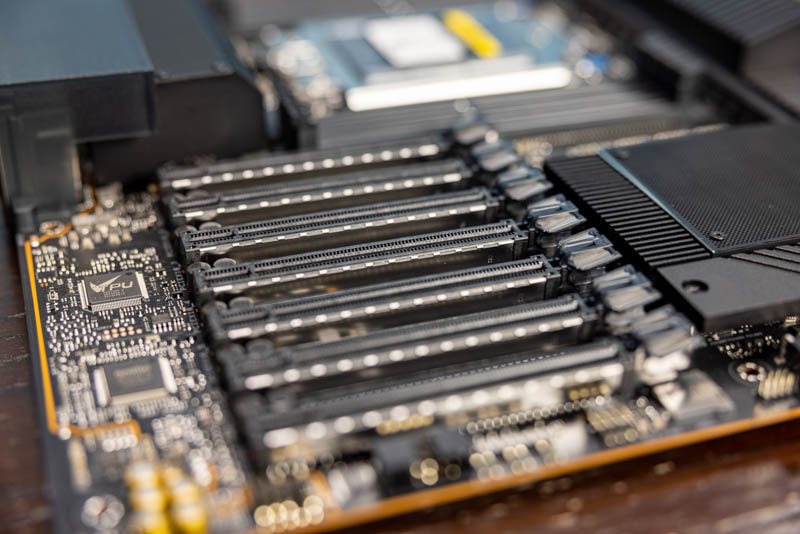
The motherboard comes with a 4x M.2 SSD card, which we used for our SSDs.
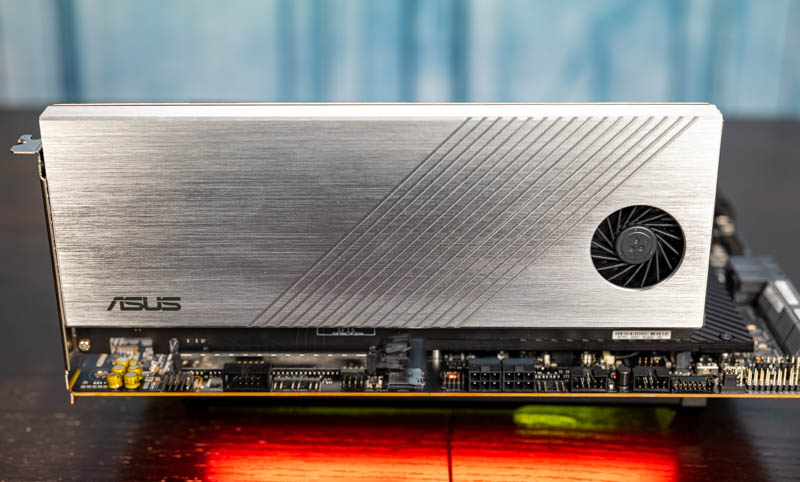
One quick note, this was the platform where we had a Micron DIMM spectacularly fail in. I was running the tests remotely and called Patrick our editor-in-chief to let him know the performance was not good, then a reboot did not work. Upon inspection he found this:
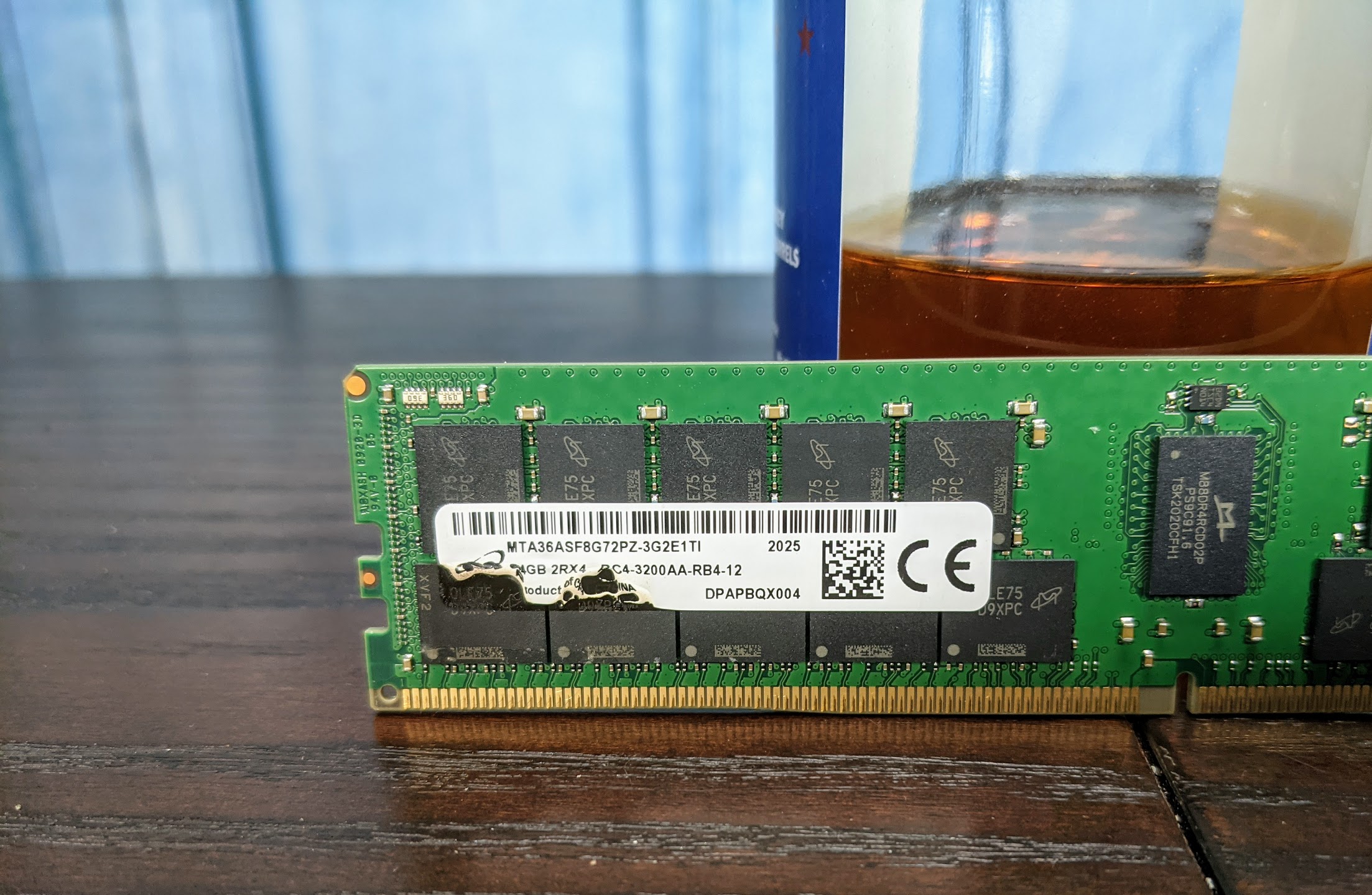
One of the eight Micron DIMMs decided to listen to Incubus’s Pardon Me too many times and attempted to “burst into flames” (really just burn its label.) We ordered a replacement since we could not get a replacement from Micron in time and the replacement is working.
AMD Ryzen Threadripper Pro 3975WX Linux Benchmarks
For this exercise, we are using our legacy Linux-Bench scripts which help us see cross-platform “least common denominator” results we have been using for years as well as several results from our updated Linux-Bench2 scripts. At this point, our benchmarking sessions take days to run and we are generating well over a thousand data points. We are also running workloads for software companies that want to see how their software works on the latest hardware. As a result, this is a small sample of the data we are collecting and can share publicly. Our position is always that we are happy to provide some free data but we also have services to let companies run their own workloads in our lab, such as with our DemoEval service. What we do provide is an extremely controlled environment where we know every step is exactly the same and each run is done in a real-world data center, not a test bench.
We are going to show off a few results, and highlight a number of interesting data points in this article.
Python Linux 4.4.2 Kernel Compile Benchmark
This is one of the most requested benchmarks for STH over the past few years. The task was simple, we have a standard configuration file, the Linux 4.4.2 kernel from kernel.org, and make the standard auto-generated configuration utilizing every thread in the system. We are expressing results in terms of compiles per hour to make the results easier to read:
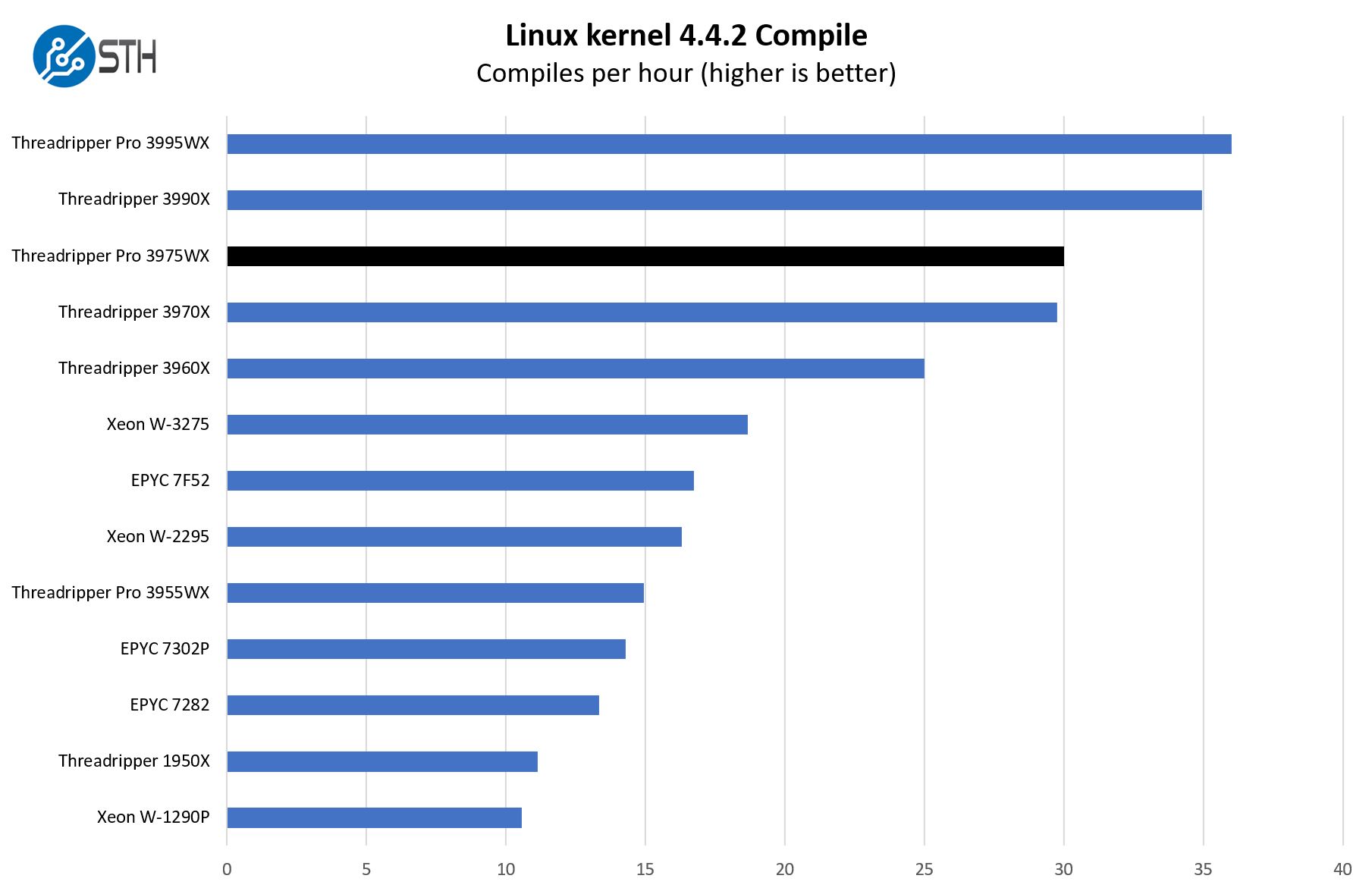
In this section, we are going to show a few views mostly comparing the Threadripper Pro line, Threadripper, and the higher-end Xeon W parts just to get some sense of scale. Since these charts get somewhat repetitive, we are going to try a format just highlighting our key takeaway for each.
Here we get a nice uplift over the Threadripper 3970X which is consistent with what we saw on the 64-core 3995WX v. 3990X. Our sense is that this is the impact of memory bandwidth on the solution.
c-ray 1.1 Performance
We have been using c-ray for our performance testing for years now. It is a ray tracing benchmark that is extremely popular to show differences in processors under multi-threaded workloads. We are going to use our 8K results which work well at this end of the performance spectrum.
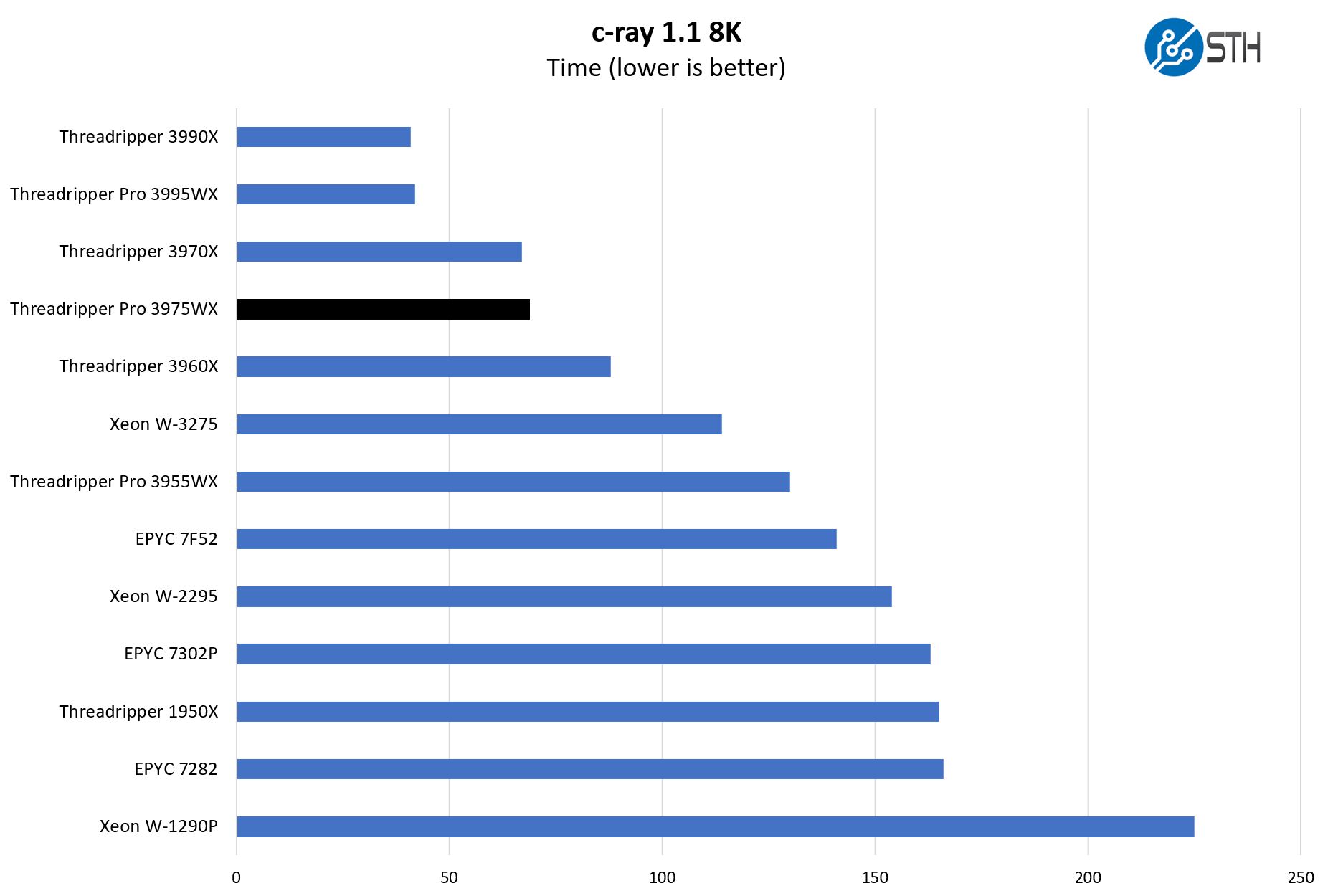
This test is heavily influenced by microarchitecture. AMD does well here for the same reason it does well on Cinebench testing for Windows. This is not stressing the memory bandwidth of the system so we see generally better performance on the consumer-oriented parts. At the same time, this is not a huge delta on either side. We usually say c-ray and Cinebench are not the best indicators of overall performance because they are so contained within CPU caches.
7-zip Compression Performance
7-zip is a widely used compression/ decompression program that works cross-platform. We started using the program during our early days with Windows testing. It is now part of Linux-Bench.
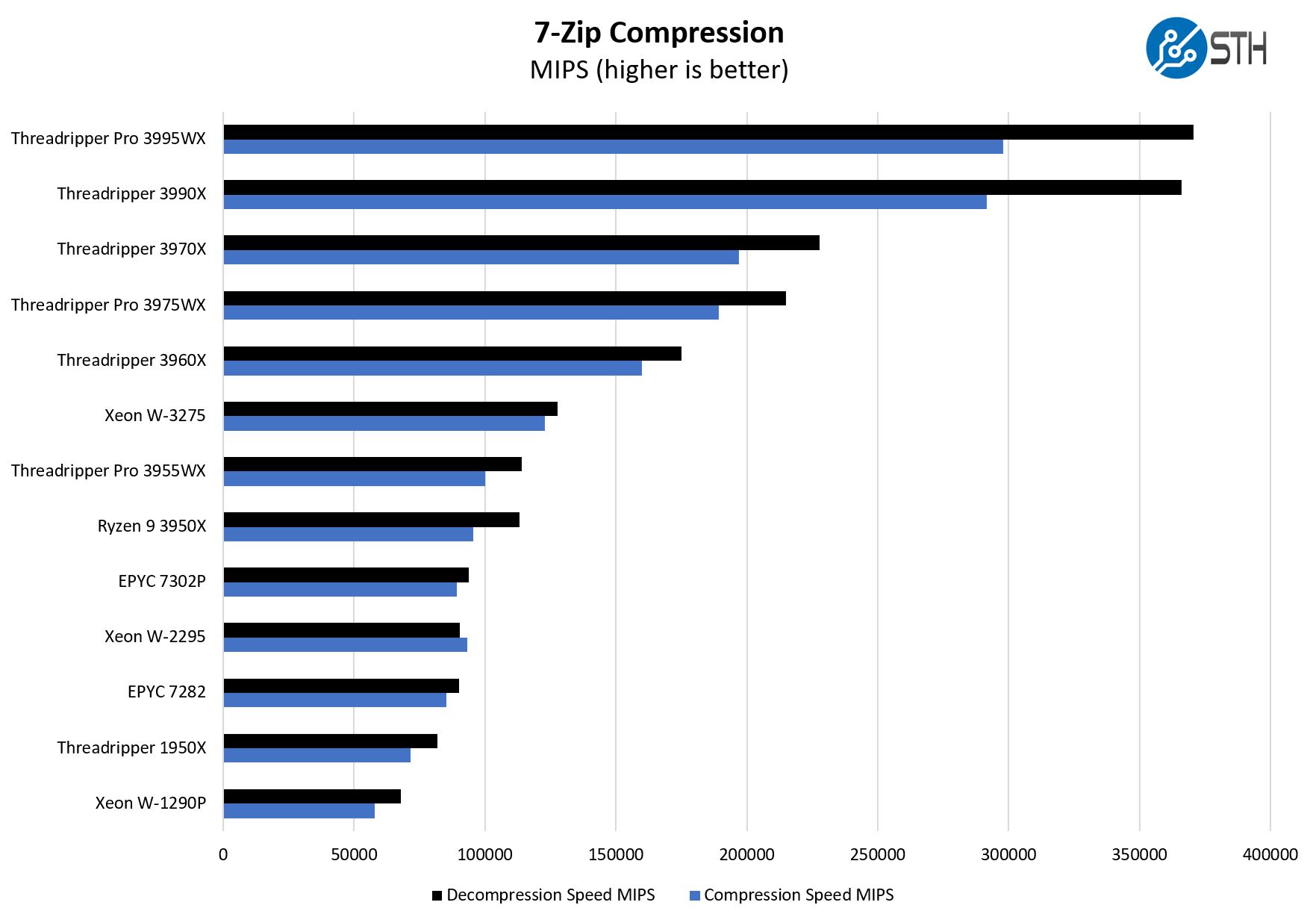
AMD tends to perform well here. Here we can see that the 32 core parts have the 3970X slightly leading again. What is the bigger story is that one can see the delta between these 32-core parts have a nice gain over the 3955WX 16-core part. AMD does not have a 24-core WX or Threadripper Pro part, but it would likely fall between the two based on the 3960X.
NAMD Performance
NAMD is a molecular modeling benchmark developed by the Theoretical and Computational Biophysics Group in the Beckman Institute for Advanced Science and Technology at the University of Illinois at Urbana-Champaign. More information on the benchmark can be found here. Here are the comparison results for the legacy data set:
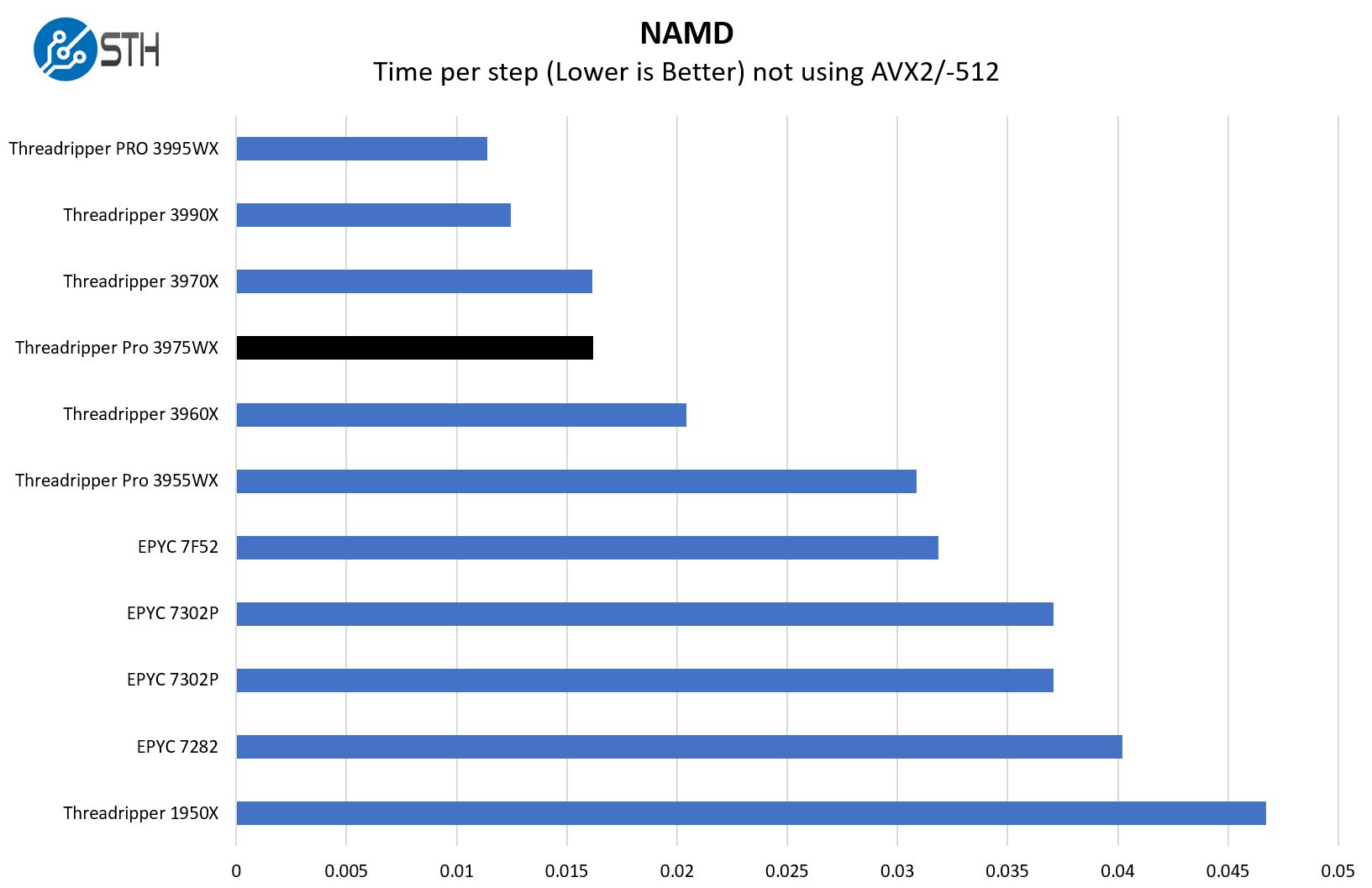
Here we see some generally solid performance. We are only showing AMD parts since we are not using key acceleration technologies like AVX2/ AVX-512.
Sysbench CPU test
Sysbench is another one of those widely used Linux benchmarks. We specifically are using the CPU test, not the OLTP test that we use for some storage testing.
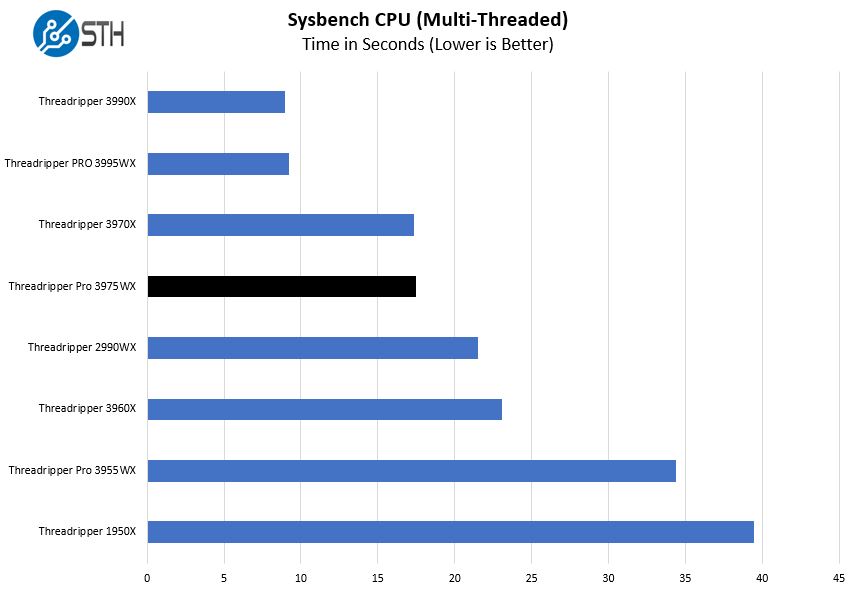
Focusing on the Threadripper series, one can see that despite having 32 cores as well, there is a massive speed-up with the newer chip versus the older AMD Ryzen Threadripper 2990WX. Zen2 was a major step forward in the architecture.
OpenSSL Performance
OpenSSL is widely used to secure communications between servers. This is an important protocol in many server stacks. We first look at our sign tests:
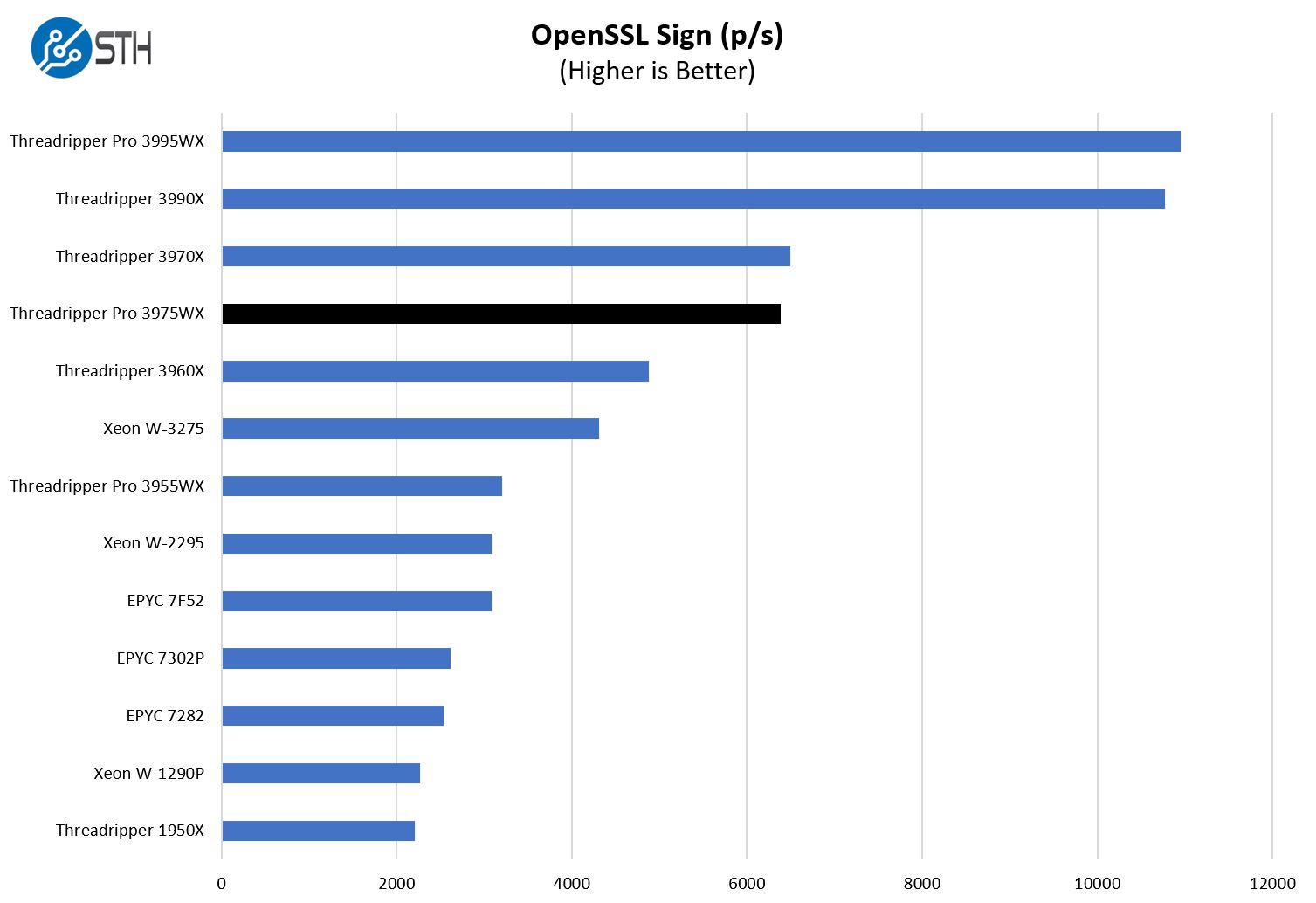
Here are the verify results:
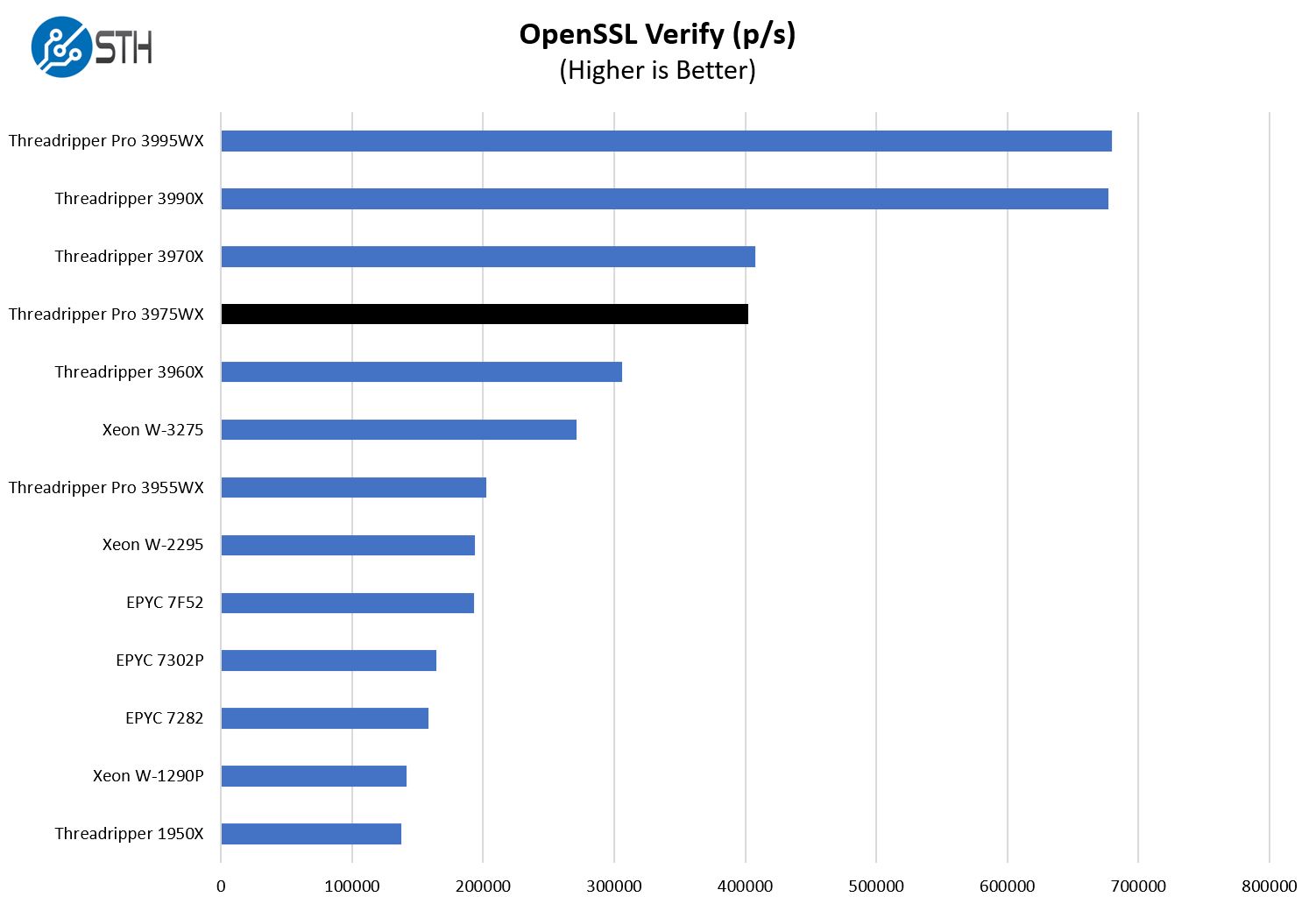
Here we see good results, that are well ahead of the Intel Xeon W-2295 and Xeon W-3275. Given the lack of Ice Lake Xeon parts on the market, these are still current generation Intel Xeon parts for workstations and even at this 32-core level, we see a fairly massive lead.
UnixBench Dhrystone 2 and Whetstone Benchmarks
Some of the longest-running tests at STH are the venerable UnixBench 5.1.3 Dhrystone 2 and Whetstone results. They are certainly aging, however, we constantly get requests for them, and many angry notes when we leave them out. UnixBench is widely used so we are including it in this data set. Here are the Dhrystone 2 results:
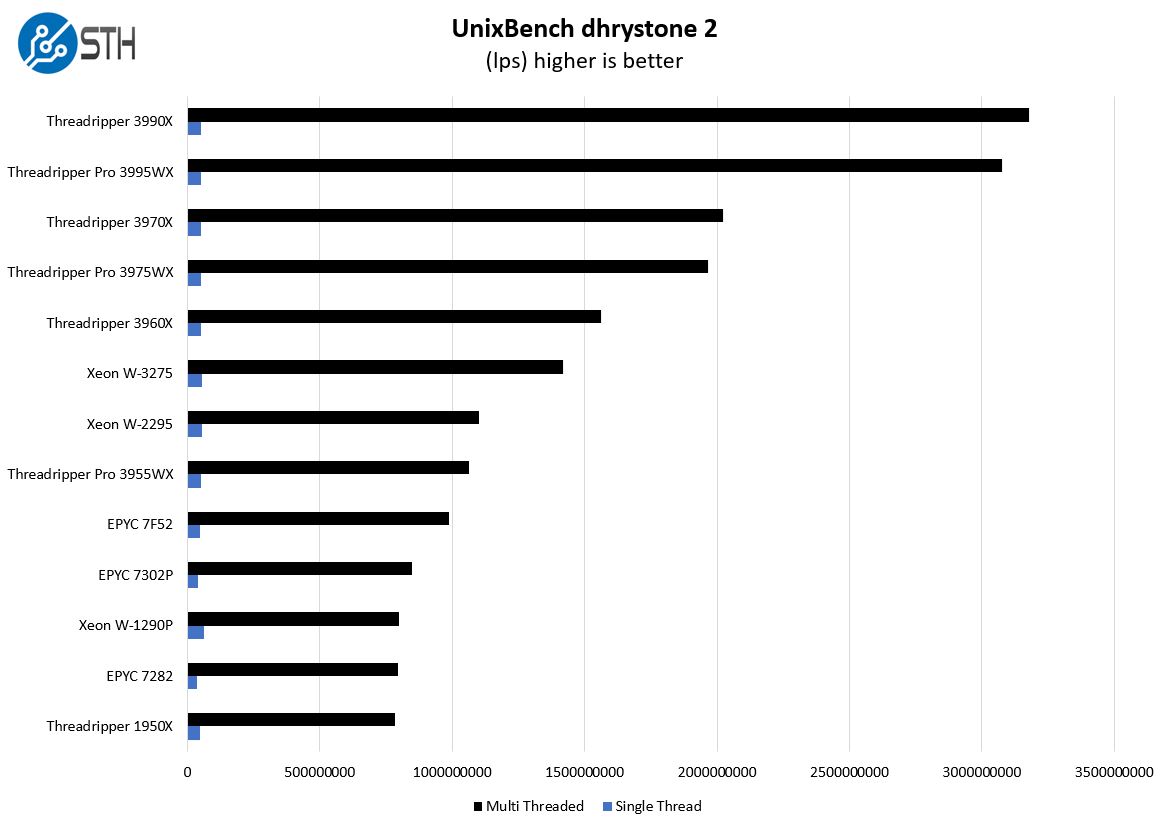
Here are the whetstone results:
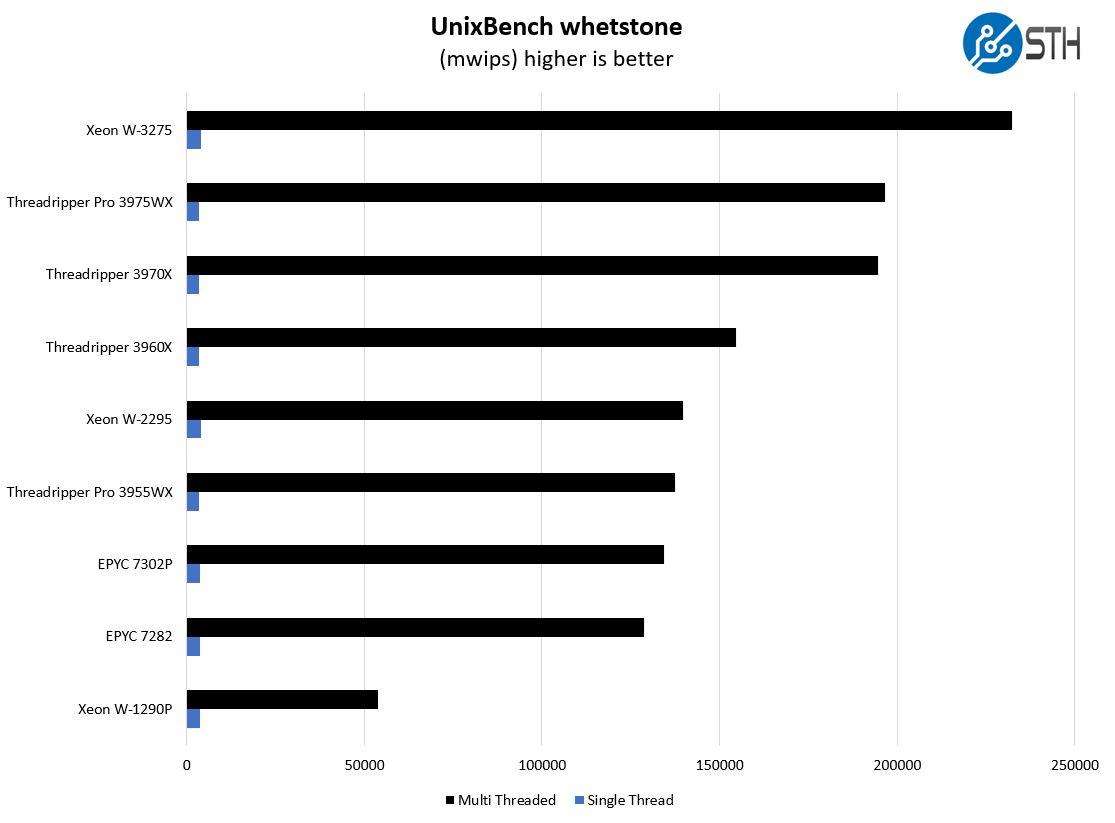
This is an older benchmark that we are not too fond of. Still, we get requests for it. On the whetstone side we see solid performance from the Intel Xeon W-3275, but for the majority of use cases the Threadripper Pro 3975WX will be faster.
Chess Benchmarking
Chess is an interesting use case since it has almost unlimited complexity. Over the years, we have received a number of requests to bring back chess benchmarking. We have been profiling systems and are ready to start sharing results:
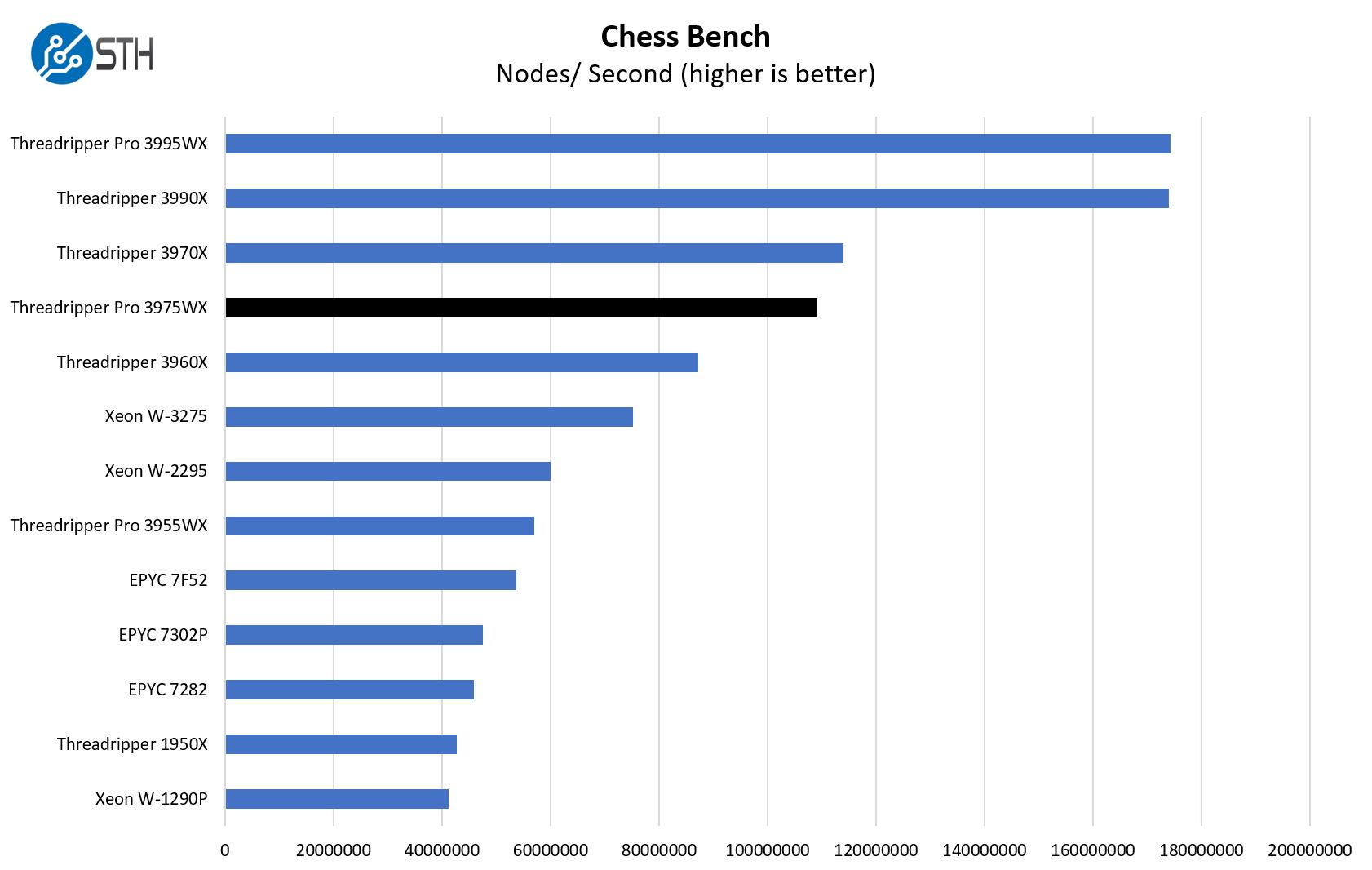
This is one where we see AMD results generally congregate around core count groups. At the same time, we do want to point out that AMD has yet to release its Zen 3-based workstation parts. This was a test that we saw with the EPYC 7003 series saw a major boost with Zen 3 due to microarchitecture/ instruction performance changes.
Next, we are going to discuss the market impact of these chips.




Thank you for the review and including the TR 1950x. Gives a good perspective how much things have improved. (I’m actually still on 1950x, so this really shows how bad i should consider an upgrade)
Second is the future compatibilty with Zen3, wonder if current TR platforms (pro and non-pro) will support them, or will they pull another move and replace the platform?
That Asus board though.. a dream board, and the only one on my list (Gigabyte is second potential pending reviews…)
My understanding is the 3970 has 4 memory channels while the 3975 has 8. I would have expected there are scientific workstation tasks that run much faster with the extra memory bandwidth. At the same time, none of the tests in this review show any benefit.
Were all 8 memory channels active during the testing?
Did you compare with only 4 channels populated to see if there is any difference?
Could you look for a new benchmark that can tell the difference between 4 and 8 channel memory systems?
I disagree entirely about streamlining the product lines. What they need to do is make normal Threadripper processors with fewer than 24 cores as well.
The Ryzen platform has too few PCIe lanes and expansion slots to make a real non-toy computer with. The Threadripper platform fills that need, but the startup cost is too high with the Zen 2 generation. Plenty of people need a platform with reasonable amounts of I/O, but not a huge number of cores.
Making the gap between toy Ryzen computers and Threadripper Pro/EPYC even larger would be an incredibly stupid thing to do.
They need to expand the options, not reduce them.
Again Thanks Patric for the great review
This gentleman “https://www.youtube.com/watch?v=3yOCBL1lvIA” had a memory issue with the ASUS MB, two memory sockets were out of order. I’m planning to order this MB to be shipped to Kuwait on a later stage “once this extreme shortage will be over” & it will be too expensive to ship back & fourth. By the way I trust ASUS products that is why I’m considering it not the competition
Thanks & best regards
@Thanny
[…I disagree entirely about streamlining the product lines. What they need to do is make normal Threadripper processors with fewer than 24 cores as well…]
I understand where you’re coming from with this. I felt the same thing at some point. I was happy with a 2950X (I luckily got it used for $700 mid-2019, now it is at $950 on NewEgg, crazy) and it was a shock to see the 3960X at $1400 MSRP as lowest option. But I went ahead replacing the 2950X with the 3960X. Reason: I was also using a 3900X which was more performing than the 2950X on (mildly) threaded apps. I recycled the 2950X as server. The way I compute the cost is to spread the price on N years. Example: $1400 on 10 years = $12 a month. Yes, I can live with that. Why ten years? Because my previous PCs were from 2008. So null doubt that the 3960X workstation is going to last a long time for enterprise software dev, databases, VMs, etc. I’m not a graphices/creator guy.
[…The Ryzen platform has too few PCIe lanes and expansion slots to make a real non-toy computer with. The Threadripper platform fills that need, but the startup cost is too high with the Zen 2 generation. Plenty of people need a platform with reasonable amounts of I/O, but not a huge number of cores…]
They won’t. If they were to go beyond 24 lanes, they would start to cannibalize their HPC and Epyc markets. INTEL does the exact same thing. Let’s imagine you had a Ryzen 9 5950X with 48 lanes, there would be many “creator” workshops (multi-graphics cards) or small businesses in need of servers with accelerator cards and/or 25/40GbE network jumping on the occasion at the expense of TR and Epyc. AMD does not want to cannibalize its products, it wants to cannibalize INTEL products.
Just putting their shoes on to explain their reason.
In addition, AMD does it because it can: INTEL has currently no answers to AMD TR.